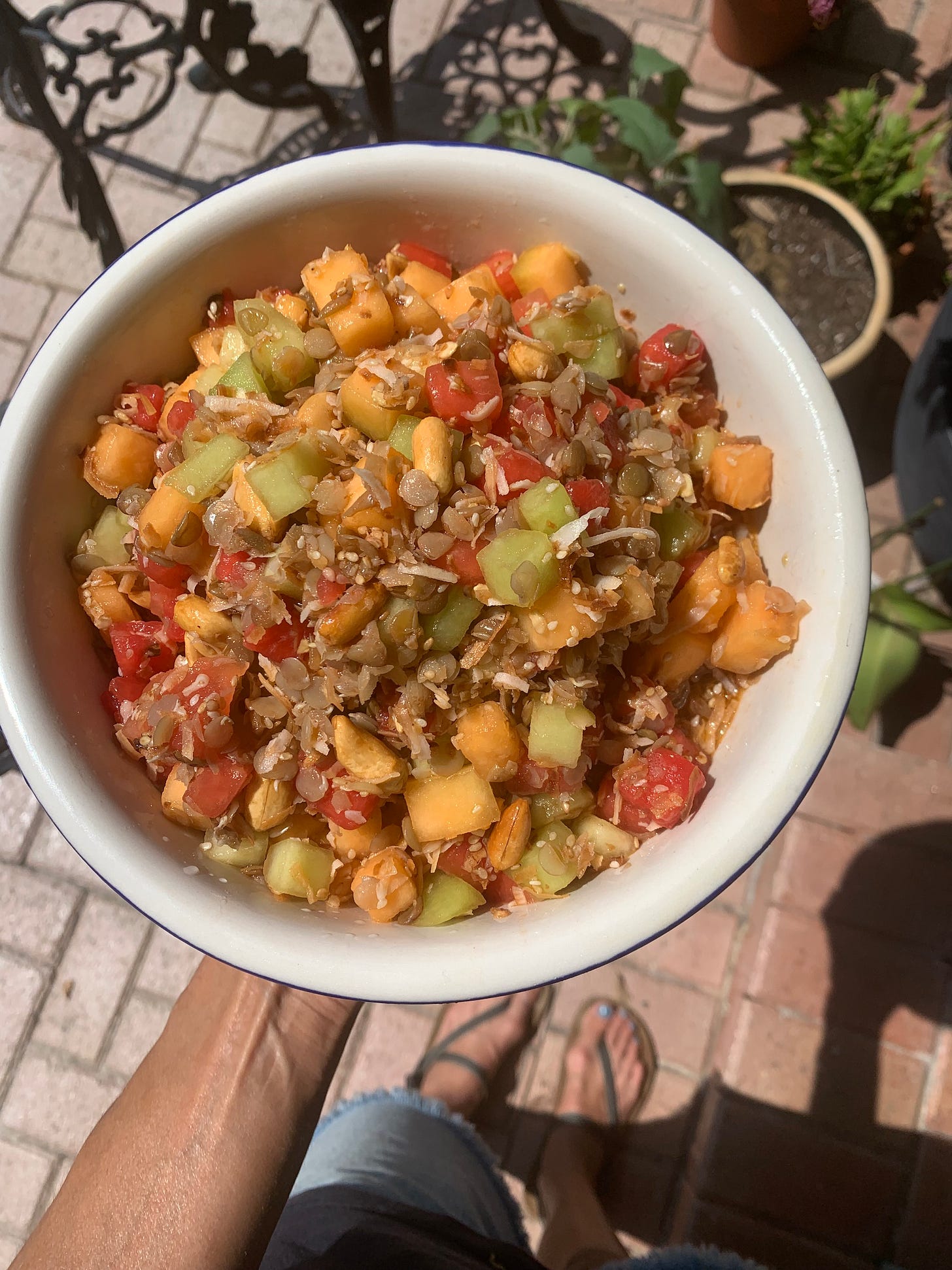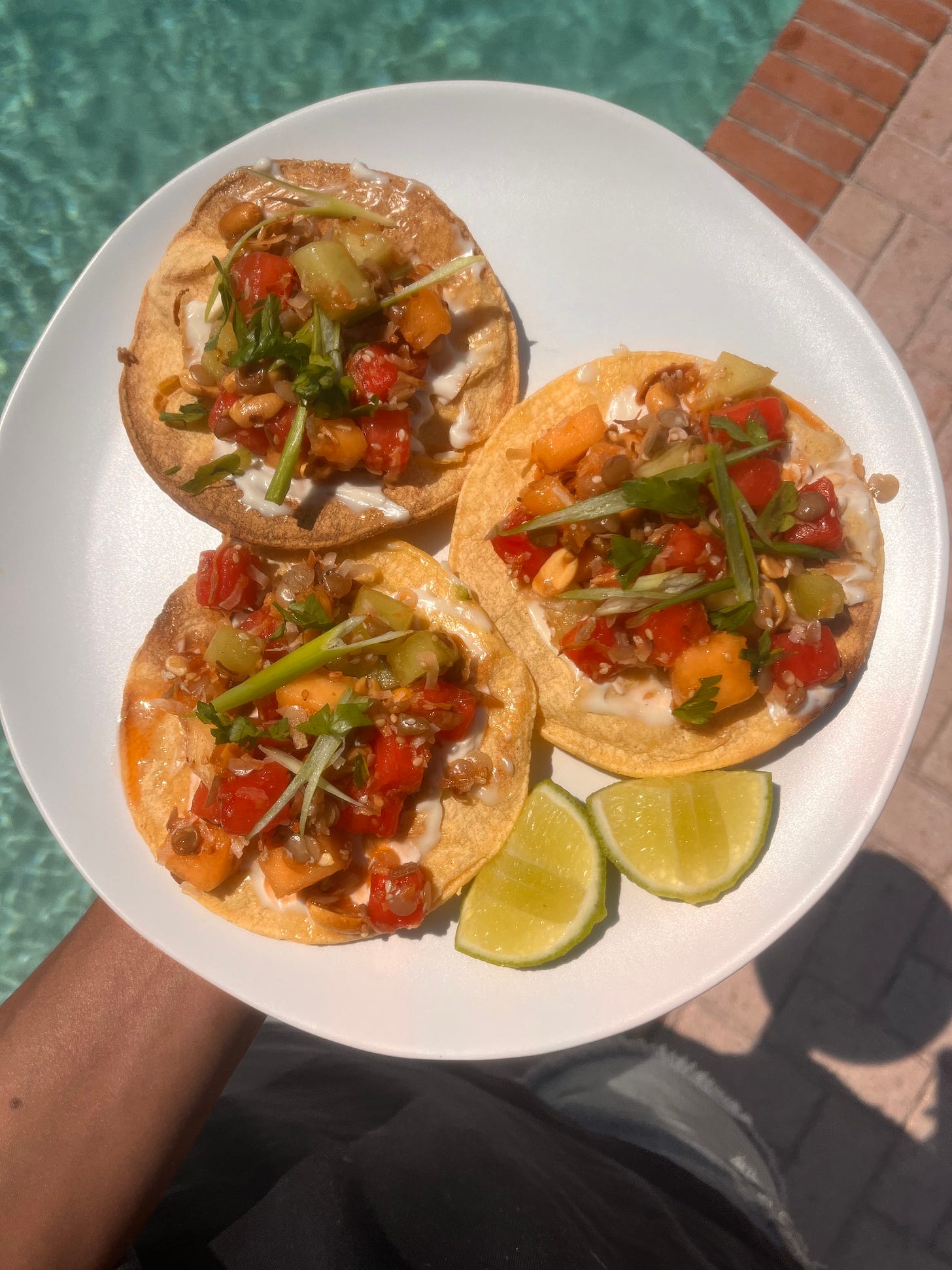Antipast-oh-no-you-didn't: Make melon a main course
Bringing an acidic tang to a seasonal favorite means you may never waste melon again.
Have you ever wept (the good tears) eating your first heirloom tomato of summer? Or bust into a happy dance when rhubarb stalks hit the market in May? Is that just me? (I’m fine if it’s just me.) The pleasure signals we get from ripe, in-season produce are undeniable, but that yummy feeling is only part of the picture.
Eating seasonal fruit and veg makes the environment happy, too. Food typically travels fewer miles to get to your kitchen, can skip the long refrigeration cycle necessary to preserve off-season produce, and thrives without climate-controlled greenhouses. Plus, when something is poppin’ off, farmers have a lot of it to unload. Psst, that means it’s cheaper. So here at Cool Beans, we’re going to make a habit of spotlighting seasonal ingredients. First up is a juicy one: We’re talking melons.
Sweet, cooling, thirst-quenching melons are the only reward I seek for surviving the most brutal parts of summer. I like to eat them straight-up, with a spoon, preferably poolside. If I’m feeling indulgent, I’ll cut them into wedges and drizzle ‘em with my best olive oil and a sprinkle of Maldon salt. Melons love salt, but they adore acid. Upping their PH with even a simple squeeze of lime boosts their natural sweetness.
If you’re like me, and wind up with more melon than you can consume before it starts to ferment, I’ve got good news: Mastering acid will help you get more life out of your favorite seasonal goodies. That means pickling, or making actual meals out of melons.
Part I: Not another watermelon-feta salad
This hearty, tangy riff on a Burmese classic has big ceviche energy
Melons have a sweet and musky complexity that pairs well with all kinds of flavors, especially salty things like cured meats and cheeses. That’s why I bypassed so-many iterations of prosciutto-wrapped cantaloupe and watermelon-feta mixes before I landed on something that would satisfy my plant-based pursuits: a melange of melons lightly pickled with a zingy soy-ginger dressing and tossed with many of my favorite things. Lentils! Coconuts! Peanuts! The blogosphere serves up several riffs on this idea, but they all trace back to a recipe from celeb chef Susan Feniger’s 2012 cookbook Street Food, which itself takes inspiration from a Burmese digestive called gyin thoke (literally, ginger salad).
Diced cantaloupe, honeydew, and watermelon make up the base of the dish. The fruit hangs out in a dressing of ginger, sesame seeds, lime juice, soy sauce, olive oil, sugar, and salt while the rest of the salad comes together. The marinating melons reminded me of ceviche, or at least something I wanted to pile onto a tortilla chip. Of course, the acid isn’t cooking the melons the way it would fish or shrimp, but it is working its tangy way into the fruit. (Note to your future selves: Don’t toss the rinds. Pickled, they make an excellent l’il snack, which we’ll get to later.)
While the melons chilled in their gingery-soy bath I cooked a pot of green lentils, and toasted 1 ¼ cups of peanuts and 2 cups of coconut flakes in olive oil with some kaffir lime until my kitchen smelled so good I almost couldn’t take it. (If you can’t find kaffir lime, regular lime zest will do.) This toasty, citrusy mix makes its way into the melon bowl, and the dish is done. It took about 90 minutes for it all to come together. To be fair, a good chunk of that was just peeling watermelon, but I was rewarded with plenty of rinds for Operation Pickle and six hearty servings of melon salad.
Feniger calls this a “summertime side dish,” but the protein-boost from lentils and peanuts means it can moonlight as lunch, or even dinner? Seriously: One 1 ½ cup serving has around 15 grams of protein and 9 grams of fiber. The Southeast Asian flavor profile is a welcome antidote to the tired antipasto-leaning melon salads that typically fill summer picnic tables. Feniger’s version hits that sweet-salty balance thanks to the dressing toning down the sugar in the melon—and it gets better as you eat it. It’s crisp and juicy, yet creamy from the lentils and punctuated with crunch.
Unable to get the idea of ceviche out of my head, I honored my craving and made gyin thoke melon tostadas, which I highly recommended. Melons for supper. Mission: accomplished. Next time, I might take an extra cue from traditional Burmese gyin thoke and use pickled ginger. Sure, I could buy some at an Asian supermarket, but we can make quick work of pickling at home. Shall we?




